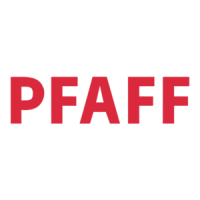
Do you have a question about the Pfaff hobby 382 and is the answer not in the manual?
| Brand | Pfaff |
|---|---|
| Model | Hobby 382 |
| Foot Control | Yes |
| Maximum Stitch Width | 5 mm |
| Maximum Stitch Length | 4 mm |
| Weight | 6 kg |
| Bobbin Type | Class 15 |
| Type | Sewing Machine |
| Stitch Width | 0-5 mm |
Specifies wire colors (blue/neutral, brown/live) for UK mains lead connections to prevent shock.
Key instructions to reduce electric shock risk, including unplugging and water safety.
Precautions to prevent fire, burns, electric shock, or injury to persons, especially children.
Step-by-step instructions for connecting the foot control and power plug to the sewing machine.
Steps to prepare the machine for bobbin winding, including removing work support and bobbin case.
Detailed steps for winding the bobbin thread from the spool onto the bobbin.
Instructions on how to re-engage the sewing mechanism after bobbin winding.
Guide on how to correctly insert the wound bobbin into the bobbin case and machine.
How to check and adjust the bobbin thread tension for optimal sewing results.
Steps for correctly inserting the bobbin case into the sewing machine hook assembly.
Step-by-step guide for threading the needle and upper thread through the machine.
Specific instructions on how to thread the needle from front to back.
How to bring the bobbin thread up to the needle area after upper threading.
Instructions for positioning the upper and lower threads correctly under the sewing foot.
Information on the free arm feature for sewing tubular items.
How to attach the detachable work support to the machine for added workspace.
Guides on placing fabric under the sewing foot and lowering the presser bar lifter.
How the foot control operates the sewing machine speed.
Guide to checking and adjusting needle thread tension using the stitch pattern selector.
Essential tips for achieving good sewing results, focusing on needle and thread tensions.
Instructions on how to set the stitch length regulator for desired stitch size.
How to use the reverse-feed control button for backtacking and securing seams.
Guide to selecting stitch patterns using the selector ring and display window.
Instructions for sewing stretch stitches, including positioning the 'Stretch' indicator.
References to tables for utility and stretch stitch patterns.
Table detailing symbols, names, and applications for various utility stitches.
Instructions for straight stitching on different models, including needle position.
Table detailing symbols, names, and applications for various stretch stitches.
Step-by-step guide for replacing the sewing machine needle correctly.
How to attach the darning/embroidery plate to cover the feed dog.
Illustrations and names of standard sewing feet included with the machine.
Instructions on how to open and use the accessory storage compartment.
Instructions for adjusting zigzag width and stitch patterns on different models.
Guidance on performing top-stitching and using the edge guide for parallel seams.
How to attach and adjust the edge guide for precise top-stitching and edge work.
Instructions for the elastic blind stitch using the blindstitch foot G.
How to adjust the needle penetration for optimal elastic blind stitching results.
Detailed steps for sewing buttonholes using different stitch pattern selections.
Instructions for sewing standard buttons onto fabric, including stitch selection.
Guide for sewing buttons with stems on heavy materials.
Instructions for inserting a standard zipper using the zipper foot E.
Guide for sewing a seam-like concealed zipper, including fitting the foot.
Specific instructions for inserting zippers into ladies' trousers for a neat finish.
How to fit the darning foot and perform darning operations on fabric.
Detailed steps for installing a seam-like zipper, ensuring correct alignment.
Instructions for cleaning the feed dog, hook raceway, and other machine parts.
Guidance on applying oil to the hook raceway for smooth operation.
Steps for safely removing the old bulb and installing a new 15-watt bulb.
Overview of different needle types, their profiles, and suitability for various fabrics.
Guidance on choosing the correct needle based on fabric weight and stitch type.
Diagnosing and fixing issues where the machine skips stitches.
Troubleshooting common causes for the needle thread breaking.
Identifying reasons for needle breakage and how to prevent it.
Addressing problems causing uneven stitches and poor seam quality.
Solutions for when the machine feeds fabric irregularly or not at all.
Troubleshooting causes for the machine running with difficulty or resistance.
Critical operational notes, including not running the machine without fabric and unplugging.
List of special accessories, their part numbers, and intended sewing operations.